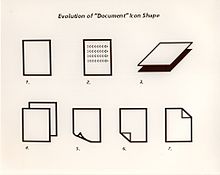Xerox Star
The Xerox Star workstation, officially named Xerox Star 8010 Information System, is the first commercial personal computer to incorporate technologies that have since become standard in personal computers, including a bitmapped display, a window-based graphical user interface, icons, folders, mouse (two-button), Ethernet networking, file servers, print servers, and email.[2][3] Introduced by Xerox Corporation on April 27, 1981, the name Star technically refers only to the software sold with the system for the office automation market.The Alto had been strongly influenced by what its designers had seen previously with the NLS computer system at the Stanford Research Institute and PLATO at University of Illinois.[6] Although by 1979 nearly 1,000 Ethernet-linked Altos had been put into operation at Xerox and another 500 at collaborating universities and government offices,[7] it was never intended to be a commercial product.[8] Then in 1977,[9] Xerox started a development project which worked to incorporate the Alto innovations into a commercial product; their concept was an integrated document preparation system, centered on the expensive laser printing technology and targeted at large corporations and their trading partners.Much of the first year was taken up by meetings and planning, resulting in an extensive and detailed functional specification, internally termed the Red Book.Traits is a programming convention used to implement object-oriented capabilities and multiple inheritance in the customer environment of Star and Viewpoint.Tajo has many similarities with the Smalltalk-80 environment, but has many added tools, such as the version control system DF, which requires programmers to check out modules before they are changed.The software engineers had to develop new network communications protocols and data-encoding schemes when those used in PARC's research environment proved inadequate.Many software redesigns, rewrites, and late additions had to be made, variously based on results from user testing, and marketing and systems considerations.A Japanese language version of the system was produced in conjunction with Fuji Xerox, code named J-Star, and full support for international customers.Text is displayed as black on a white background, just like paper, and the printer replicates the screen using Interpress, a page description language developed at PARC.Furthermore, the design principles of Smalltalk and modeless working had been extensively discussed in the August 1981 issue of Byte magazine,[25] so Xerox PARC's standing and the potential of the Star can scarcely have been lost on its target (office systems) market, who would never have expected IBM to position a mass-market PC to threaten far more profitable dedicated WP systems.Unfortunately, the influential niche market of pioneering players in electronic publishing such as Longman were already aligning their production processes towards generic markup languages such as SGML (forerunner of HTML and XML) whereby authors using inexpensive offline systems could describe document structure, making their manuscripts ready for transfer to computer to film systems that offered far higher resolution than the then maximum of 360 dpi laser printing technologies.The multi-lingual technical documentation market was also a major opportunity, but this needed cross-border collaboration for which few sales organisations were ready at the time.Probably most significantly, strategic planners at the Xerox Systems Group (XSG) felt that they could not compete against other workstation makers such as Apollo Computer or Symbolics.Crashes can be followed by an hours-long process called file scavenging, signaled by the appearance of the diagnostic code 7511 in the top left corner of the screen.Many of the innovations behind the Star, such as WYSIWYG editing, Ethernet, and network services such as directory, print, file, and internetwork routing have become commonplace in computers.[28] Star, Viewpoint, and GlobalView were the first commercial computing environments to offer support for most natural languages, including full-featured word processing, leading to their adoption by the Voice of America, other United States foreign affairs agencies, and several multinational corporations.[29] The list of products that were inspired or influenced by the user interface of the Star, and to a lesser extent the Alto, include the Lisa, Macintosh, Graphics Environment Manager (GEM), Visi On, Windows, Atari ST, BTRON from TRON Project, Amiga, Elixir Desktop, Metaphor Computer Systems, Interleaf, OS/2, OPEN LOOK (co-developed by Xerox), SunView, KDE, Ventura Publisher, and NEXTSTEP.However, at the time, the 1975 Xerox Consent Decree, a Federal Trade Commission (FTC) antitrust action, placed restrictions on what the firm was able to patent.



Operating systemAMD Am2900EthernetXerox AltoXerox Daybreakworkstationpersonal computerbitmappedgraphical user interfacefoldersnetworkingfile serversprint serversXerox Corporationoffice automationSmalltalksoftware developmentXerox Palo Alto Research CenterStanford Research Institutelaser printingXerox MemorywriterteletypeEl Segundo, CaliforniaPalo Alto, CaliforniaOffice of the futureDavid LiddleInternetARPANETModula-2Modula-3object-orientedintegrated development environmentcodenamedXerox Development Environmentversion controlprototypingsoftware engineerscommunications protocolsJapanese languageFuji XeroxWYSIWYGInterpressDavid Canfield Smithcomputer iconsMacintoshPublish and SubscribeMicrosoft WindowsObject Linking and EmbeddingOpenDocAppleWorksvirtual-memorymicroprogrammedtransistor-transistor logic74S181emitter-coupled logicnetwork routerButler Lampsonbitslice microprocessor technologymemoryfloppy driveDhrystoneVAX-11cathode-ray tubeLisp machineDaybreakRank XeroxVIC-20laser printerInterlispIBM PCPC DOSIBM DisplaywriterXerox 9700Xerox PARCelectronic publishingLongmanmarkup languagescomputer to filmcopierScientific Data SystemsXerox 820Apollo ComputerSymbolicsRolls-Roycedesktop publishingGlobalViewSolarisWindows 3.1Windows 95Windows 98National Computer ConferenceLarry TeslerMacAppCharles SimonyiMicrosoftMicrosoft Word (3.0)Scott A. McGregorWindows 1.0natural languagesVoice of AmericaGraphics Environment ManagerVisi OnWindowsAtari STTRON ProjectMetaphor Computer SystemsInterleafOPEN LOOKSunViewVentura PublisherNEXTSTEPAdobe SystemsPostScriptde factoFederal Trade CommissionantitrustpatentApple Computer, Inc. v. Microsoft Corp.statute of limitationsPilot (operating system)National Museum of American HistoryComputerCiteSeerXNorman, Donald A.Joseph C. WilsonChester Carlson